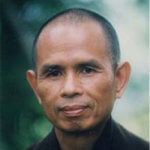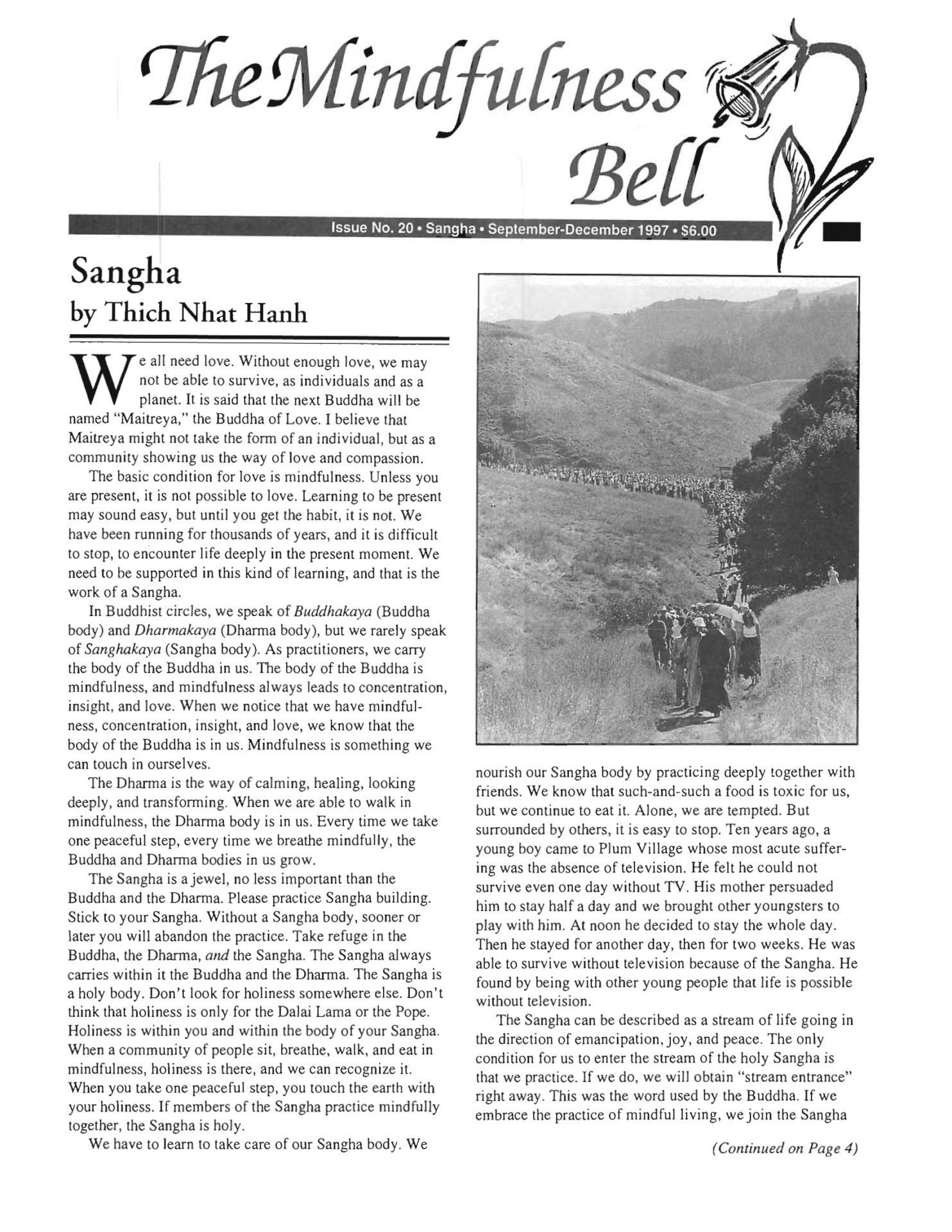By Thich Nhat Hanh in September 1997
We all need love. Without enough love, we may not be able to survive, as individuals and as a planet. It is said that the next Buddha will be named “Maitreya,” the Buddha of Love. I believe that Maitreya might not take the form of an individual, but as a community showing us the way of love and compassion.

The basic condition for love is mindfulness.
By Thich Nhat Hanh in September 1997
We all need love. Without enough love, we may not be able to survive, as individuals and as a planet. It is said that the next Buddha will be named "Maitreya," the Buddha of Love. I believe that Maitreya might not take the form of an individual, but as a community showing us the way of love and compassion.

The basic condition for love is mindfulness. Unless you are present, it is not possible to love. Learning to be present may sound easy, but until you get the habit, it is not. We have been running for thousands of years, and it is difficult to stop, to encounter life deeply in the present moment. We need to be supported in this kind of learning, and that is the work of a Sangha.
In Buddhist circles, we speak of Buddhakaya (Buddha body) and Dharmakaya (Dharma body), but we rarely speak of Sanghakaya (Sangha body). As practitioners, we carry the body of the Buddha in us. The body of the Buddha is mindfulness, and mindfulness always leads to concentration, insight, and love. When we notice that we have mindfulness, concentration, insight, and love, we know that the body of the Buddha is in us. Mindfulness is something we can touch in ourselves.
The Dharma is the way of calming, healing, looking deeply, and transforming. When we are able to walk in mindfulness, the Dharma body is in us. Every time we take one peaceful step, every time we breathe mindfully, the Buddha and Dharma bodies in us grow.
The Sangha is a jewel, no less important than the Buddha and the Dharma. Please practice Sangha building. Stick to your Sangha. Without a Sangha body, sooner or later you will abandon the practice. Take refuge in the Buddha, the Dharma, and the Sangha. The Sangha always carries within it the Buddha and the Dharma. The Sangha is a holy body. Don't look for holiness somewhere else. Don't think that holiness is only for the Dalai Lama or the Pope. Holiness is within you and within the body of your Sangha. When a community of people sit, breathe, walk, and eat in mindfulness, holiness is there, and we can recognize it. When you take one peaceful step, you touch the earth with your holiness. If members of the Sangha practice mindfully together, the Sangha is holy. We have to learn to take care of our Sangha body. We nourish our Sangha body by practicing deeply together with friends. We know that such-and-such a food is toxic for us, but we continue to eat it. Alone, we are tempted. But surrounded by others, it is easy to stop. Ten years ago, a young boy came to Plum Village whose most acute suffering was the absence of television. He felt he could not survive even one day without TV. His mother persuaded him to stay half a day and we brought other youngsters to play with him. At noon he decided to stay the whole day. Then he stayed for another day, then for two weeks. He was able to survive without television because of the Sangha. He found by being with other young people that life is possible without television.
The Sangha can be described as a stream of life going in the direction of emancipation, joy, and peace. The only condition for us to enter the stream of the holy Sangha is that we practice. If we do, we will obtain “stream entrance” right away. This was the word used by the Buddha. If we embrace the practice of mindful living, we join the Sangha and enter the stream. This is the first holy fruit we obtain as a practitioner. It is not difficult. If you want to practice in a joyful way, build a Sangha where you are. The Sangha is your protection. It is the raft that will carry you to the shore of liberation. Without a Sangha, even with the best of intentions, your practice will falter. "I take refuge in the Sangha" is not a declaration of faith. It is a daily practice.
If there is love between teacher and student and among the students themselves, you will be able to put down roots in the Sangha. When I became a monk, I was loved by my teacher and fellow monks. Later, when I had to leave the warm atmosphere of the temple, I encountered many storms. But the roots that had grown in the temple could never die, and I was able to continue steadily on the path of practice. Many people today are unable to put down roots in their families, churches, or society. If these people come to a Sangha of practice and see it as wholesome, true, and worthy of their confidence, they will be able to put down roots. It may be easier to love in a Sangha than in our own family, because in a Sangha we are all going in the same direction. Later, we can return home and help rebuild our family, church, and society.
If you are going to dig a well, you cannot dig down a few inches and say, "I give up. There are too many stones." Your teacher and your brothers and sisters are the earth you are digging into. Digging a well is not easy. If you throw away your practice—your shovel—you will not succeed. Dig down inside yourself, into your own mind. Drink the pure, sweet water of the earth. When you have difficulties with your teacher or friends, you have to find the roots of the difficulties. It may be a matter of needing to reorganize things or something simple like that. Be open to discovering new ways of being together. Thanks to such difficulties, we see how to continue the work of transforming.
If you have a difficult Dharma sister or brother, help her, because she is you. If you cannot help her, you will not be successful in your own practice. If you continue to exist as an individual and think that happiness is an individual matter, you will not succeed. When you have put your roots down in each other, the feelings of isolation and loneliness will be transformed. You are no longer merely an individual. You carry in your heart all your brothers, sisters, and ancestral teachers.
Sangha building is an art. To take care of the Sangha is to take care of the Buddha. Through a Sangha, it is possible to be in touch with the living Dharma. To take care of the Sangha is to take care of ourselves, and to take care of ourselves is to take care of our Sangha. When we eat and drink in moderation, we are looking after our Sangha body. When we look after a brother or sister and help them smile again, we are looking after the Sangha. When we take our younger sister's hand and console her, we are looking after the Sangha. When we reconcile with our brother, the whole community will feel better, and we are looking after the Sangha. It is not enough just to go into the meditation halland offer incense to the Buddha. When we cause our Sangha to be healed, we are healing the body of the Buddha.
A young man told me, "I am happy to take refuge in the Buddha and the Dharma, but I cannot respect the Sangha." He did not understand that each jewel contains all three jewels. Without the Sangha, there can be no Buddha and no Dharma. An elderly friend told me, "I only take refuge in a Holy Sangha, the Sangha of saints who lived in the past. In the present time, there is no Holy Sangha." But a Sangha that is made of people of this world is the only Sangha we have. If my friend had been on Vulture Peak when the Buddha was giving teachings, he would have seen many disturbing elements in the Buddha's own Sangha. When we read the Vinaya, we can see that. We need a Sangha that we can touch in the present moment, made up of all kinds of people. They may not be fully enlightened, but if they can support us in our practice, that alone makes them a worthy object of our refuge. They may not be saints, but they are the Sangha we have.

The best way to improve the quality of the Sangha is to improve the quality of our own practice. If members of the Sangha practice mindfulness and have been liberated from the worst part of their suffering, the Sangha is a jewel that can help many people. Our community in Plum Village is by no means perfect. It is a community of ordinary people on the path of practice. But if our Sangha practices well, it can become a Sangha of deep realization. The holy element is there in each member of the Sangha. And with daily practice, we practice holiness every day.
In any community, it is clear that some people have more peace than others. If we leave a Sangha because some of its members are not very holy, we are leaving the holy elements as well. The practice is to help build a Sangha that has peace and joy. Every member of the community can practice this. This is the way to cultivate faith in the Sangha.
If you do not have the means to travel and live with an established Sangha, create a Sangha where you are. It can be a small community of practice with your family and friends. You can meet every day, or once a week, or even just once a month to recite the mindfulness trainings together. The work you do for the Sangha is not just washing the dishes, working in the office, or performing ceremonies. It is organizing yourself and your life in a way that brings happiness to the Sangha.
We have to learn to practice meditation collectively—as a family, a city, a nation, and a community of nations. A Sangha that practices love and compassion together is the Buddha we need for the twenty-first century. It is up to us to bring the next Buddha into existence—Maitreya, the Buddha of Love, Ms. Love, Mr. Love. We have the privilege and the duty to prepare the ground for bringing that Buddha to life—for our sake and the sake of our children and our planet. Each of us has a role to play. Each of us can bring the Buddha into our daily life by practicing mindful living. Each of us is a cell in Maitreya Buddha, the Buddha of the twenty-first century, the Buddha of Love.
This article, based on a Dharma talk given at Plum Village in September 1996, will appear as a chapter in Thich Nhat Hanh's forthcoming book, The Heart of the Buddha's Teaching, to be published by Parallax Press.


